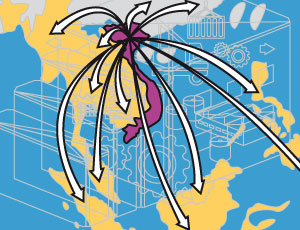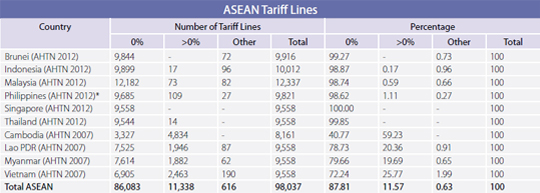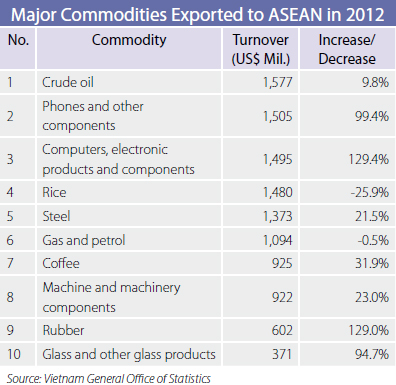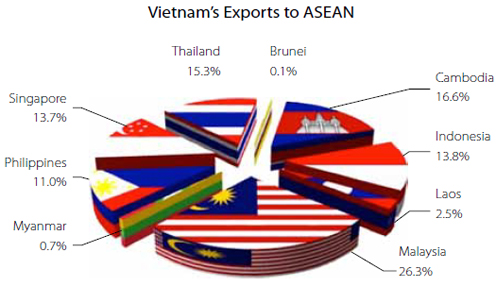Using Vietnam to Target the Emerging ASEAN Region
 Oct. 10 – Boasting more than half a billion people, abundant natural resources, and a strategic geographical location, the Association of Southeast Asian Nations (ASEAN) has the potential to become a leading global economic force in the near future.
Oct. 10 – Boasting more than half a billion people, abundant natural resources, and a strategic geographical location, the Association of Southeast Asian Nations (ASEAN) has the potential to become a leading global economic force in the near future.
Growing at an annual rate of 5 percent over the past decade, the ASEAN region – made up of Brunei, Cambodia, Indonesia, Laos, Malaysia, Myanmar, Philippines, Singapore, Thailand and Vietnam – ranks among the world’s largest emerging markets, even competing with more developed regions such as China and the European Union (EU). Looking forward, this regional economy is expected to grow by an additional US$735 billion by 2020 – the equivalent of adding another Thailand and Malaysia.
 RELATED: Dezan Shira & Associates’ Asia Business Model Comparison Services
RELATED: Dezan Shira & Associates’ Asia Business Model Comparison Services
For all these reasons, ASEAN has a great chance of surpassing the EU both in global manufacturing and consumption markets. Yet, ASEAN still has a long way to go, and both local and foreign investors still tend to view the region as 10 separate countries with unique individual business environments, institutions and cultures, instead of one unified regional trading bloc.
The emergence of ASEAN also has important implications for multinational corporations (MNCs) based outside of Southeast Asia. Until recently, many MNCs have tended to view ASEAN as either another source of low-cost labor, or as an experimental market they can test out on their way to China and India. Despite the region’s recent strides, ASEAN still has yet to scratch the surface of its vast potential as it moves to become increasingly unified as an integrated ASEAN economic community.
Why Vietnam?
While Southeast Asia’s promise remains less well known to many foreign companies when compared to China or India, an increasing number of MNCs have started to target the region. This is especially true in Vietnam due to its cheap labor resources and its positive political, economic and demographic trends.
Over the past 20 years, FDI inflows into Vietnam have increased tremendously in terms of share of investment, import/export turnover and GDP percentage. As of December 31, 2012, the country is home to 14,522 valid foreign investment projects with a total capital of over US$210.5 billion.
Specifically, manufacturing and processing have attracted the lion’s share of Vietnam’s total FDI over the past five years, accounting for approximately 72 percent of the country’s total registered capital.
The ASEAN Free Trade Area
At the Fourth ASEAN Summit in January 1992, the ASEAN heads of government agreed to establish an ASEAN Free Trade Area (AFTA) to open up their economies in the era of globalization. The AFTA was created as a response to other emerging regional groupings such as the North American Free Trade Agreement (NAFTA) area and the expansion of the EU. It was also used to push the potentials and complementaries that exist in the region in order to strengthen and deepen intra-ASEAN industrial linkages, including creating strong and competitive small and medium enterprises.
The AFTA effectively removed trade obstacles such as tariffs in order to push for freer trade among member states. The free trade area allows for companies with an ASEAN presence to take advantage of the 10 different economies in the region by way of the Common Effective Preferential Tariff (CEPT) Scheme, which minimizes the duties and tariffs paid on certain items traded within ASEAN.
All manufactured products, including capital goods and processed agricultural products, are covered by the CEPT Scheme. However, the ASEAN Trade in Goods Agreement – which entered into force in 2010 – has superseded the CEPT Scheme and has eliminated or reduced tariff lines to each ASEAN country. Please refer to the chart below for additional details.

How Does Vietnam Fit into the Picture?
As part of this fast-growing market, Vietnam has played a key role in helping ASEAN make strides in its journey towards connectivity and harmonization. As a direct result, the country has seen increased trade turnover with the rest of ASEAN lately, with exports to ASEAN reaching US$13.6 billion in 2011 and accounting for about 10 percent of the country’s total GDP in 2012 (US$138.1 billion).
Further, Vietnam submits an annual list of its tariff reductions to the ASEAN Secretariat and has reduced tariffs on over 4,000 different products, resulting in the fall of the country’s average tariff rate from 19 percent in 1995 to the present rate of 10 percent. To further enhance its standing, Vietnam expects to remove all quantitative restrictions and non-tariff barriers it currently has in the near future.
Despite the recent economic hardships in the region, Vietnamese exports to ASEAN have still maintained stable growth rates. According to the Customs Department of Vietnam, total trade turnover between Vietnam and ASEAN reached US$5.3 billion over the first two months of 2013 – a year-on-year increase of about 28.8 percent.
Vietnam’s Major ASEAN Exports
In the first two months of 2013, Vietnam had three major commodities that it has exported to emerging markets throughout ASEAN, of which turnover has increased significantly compared to the same period in 2012. Specifically, they are:
- Phone and mobile production, of which total turnover has reached US$334.7 million, accounting for 6.4 percent of Vietnam’s total turnover;
- Crude oil with a turnover of US$294.1 million – an incredible increase of 326.3 percent compared to 2012; and
- Vehicles and other related components with a turnover of US$176.8 million.
Vietnam also exports other important goods of high value throughout ASEAN in fairly large quantities, such as computer and electronic products, chemical products, and textiles.

Vietnam is poised for future growth within the region, having already pushed for stronger economic ties with ASEAN member states Singapore and Thailand within the past year. On top of that, the country has also issued a number of reforms to allow for greater freedom and participation of foreign companies in the domestic company playing field.

Specifically, earlier this year, the Vietnamese government has lent its support to a proposal by the Ministry of Finance and State Securities Commission to allow foreign firms greater stake holdings in listed companies. The draft proposal, which is still being finalized for approval by the Prime Minister, would amend certain regulations to allow foreign investors to hold up to 59 percent of a domestic company’s charter capital – an increase of 10 percent on the current cap.
Vietnam has also been pushing the development of its industrial parks (IPs) and economic zones (EZs), with the country housing a combined 334 IPs and coastal and border EZs spanning close to 780,000 hectares. Together, these zones have helped employ over 2 million people throughout the country. These IPs and EZs have attracted over US$110 billion in FDI, broken down into 4,665 projects worth US$70 billion throughout the IPs and around US$40 billion broken down throughout the coastal EZs. Furthermore, the border EZs accounted for US$700 million worth of investments, giving reason to believe that Vietnam’s zones are primed for future success.
 Portions of this article came from the September 2013 issue of Vietnam Briefing Magazine titled “Manufacturing in Vietnam to Sell to ASEAN and China,” which is currently available as a complimentary PDF download in the Asia Briefing Bookstore for a limited time only. In this issue of Vietnam Briefing Magazine, we introduce our readers to manufacturing in Vietnam as a key part of their business strategy within the ASEAN region and beyond. Specifically, we explain the new ASEAN Free Trade Area, outline what foreign investors can look forward to when creating their manufacturing presence in the country, and introduce the country’s key tax points.
Portions of this article came from the September 2013 issue of Vietnam Briefing Magazine titled “Manufacturing in Vietnam to Sell to ASEAN and China,” which is currently available as a complimentary PDF download in the Asia Briefing Bookstore for a limited time only. In this issue of Vietnam Briefing Magazine, we introduce our readers to manufacturing in Vietnam as a key part of their business strategy within the ASEAN region and beyond. Specifically, we explain the new ASEAN Free Trade Area, outline what foreign investors can look forward to when creating their manufacturing presence in the country, and introduce the country’s key tax points.
Dezan Shira & Associates is a specialist foreign direct investment practice, providing corporate establishment, business advisory, tax advisory and compliance, accounting, payroll, due diligence and financial review services to multinationals investing in emerging Asia. Since its establishment in 1992, the firm has grown into one of Asia’s most versatile full-service consultancies with operational offices across China, Hong Kong, India, Singapore and Vietnam as well as liaison offices in Italy and the United States.
For further details or to contact the firm, please email vietnam@dezshira.com, visit www.dezshira.com, or download the company brochure.
You can stay up to date with the latest business and investment trends across Vietnam by subscribing to Asia Briefing’s complimentary update service featuring news, commentary, guides, and multimedia resources.
Related Reading
 Are You Ready for ASEAN 2015?
Are You Ready for ASEAN 2015?
ASEAN integration in 2015, and the free trade agreements China has signed with ASEAN and its members states, will change the nature of China and Asia focused manufacturing and exports. In this important issue of Asia Briefing we discuss these developments and how they will impact upon China and the global supply chain.
 An Introduction to Tax Treaties Throughout Asia
An Introduction to Tax Treaties Throughout Asia
In this issue of Asia Briefing Magazine, we take a look at the various types of trade and tax treaties that exist between Asian nations. These include bilateral investment treaties, double taxation agreements, and free trade agreements – all of which directly affect businesses operating in Asia.
 An Introduction to Development Zones Across Asia
An Introduction to Development Zones Across Asia
In this issue of Asia Briefing Magazine, we break down the various types of development zones available in China, India and Vietnam specifically, as well as their key characteristics and leading advantages.
 Expanding Your China Business to India and Vietnam
Expanding Your China Business to India and Vietnam
This issue of Asia Briefing Magazine discusses why China is no longer the only solution for export driven businesses, and how the evolution of trade in Asia is determining that locations such as Vietnam and India represent competitive alternatives. With that in mind, we examine the common purposes as well as the pros and cons of the various market entry vehicles available for foreign investors interested in Vietnam and India.
- Previous Article Vietnam Seeks Indian Investment in Rubber Industry
- Next Article World Bank: Vietnam Growth, Positive Signs









